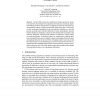Free Online Productivity Tools
i2Speak
i2Symbol
i2OCR
iTex2Img
iWeb2Print
iWeb2Shot
i2Type
iPdf2Split
iPdf2Merge
i2Bopomofo
i2Arabic
i2Style
i2Image
i2PDF
iLatex2Rtf
Sci2ools
EWCBR
2004
Springer
2004
Springer
Feature Selection and Generalisation for Retrieval of Textual Cases
Textual CBR systems solve problems by reusing experiences that are in textual form. Knowledge-rich comparison of textual cases remains an important challenge for these systems. However mapping text data into a structured case representation requires a significant knowledge engineering effort. In this paper we look at automated acquisition of the case indexing vocabulary as a two step process involving feature selection followed by feature generalisation. Boosted decision stumps are employed as a means to select features that are predictive and relatively orthogonal. Association rule induction is employed to capture feature co-occurrence patterns. Generalised features are constructed by applying these rules. Essentially, rules preserve implicit semantic relationships between features and applying them has the desired effect of bringing together cases that would have otherwise been overlooked during case retrieval. Experiments with four textual data sets show significant improvement in...
| Added | 01 Jul 2010 |
| Updated | 01 Jul 2010 |
| Type | Conference |
| Year | 2004 |
| Where | EWCBR |
| Authors | Nirmalie Wiratunga, Ivan Koychev, Stewart Massie |
Comments (0)

